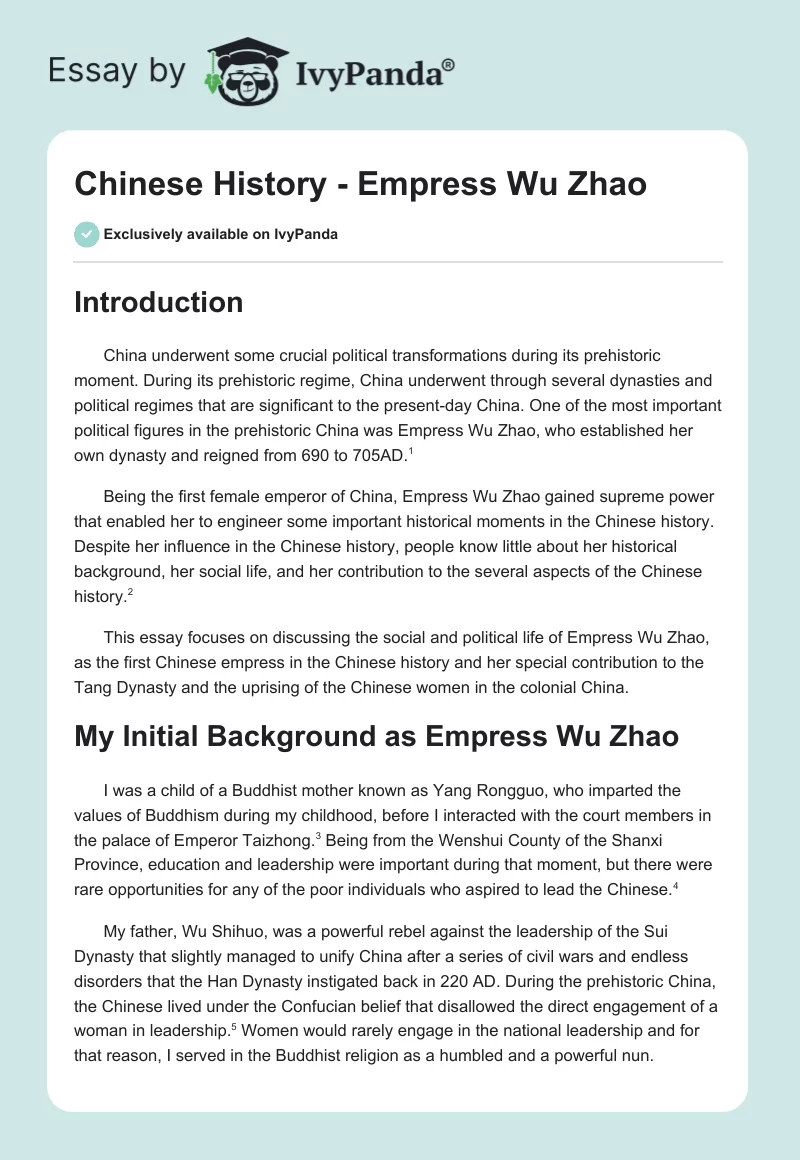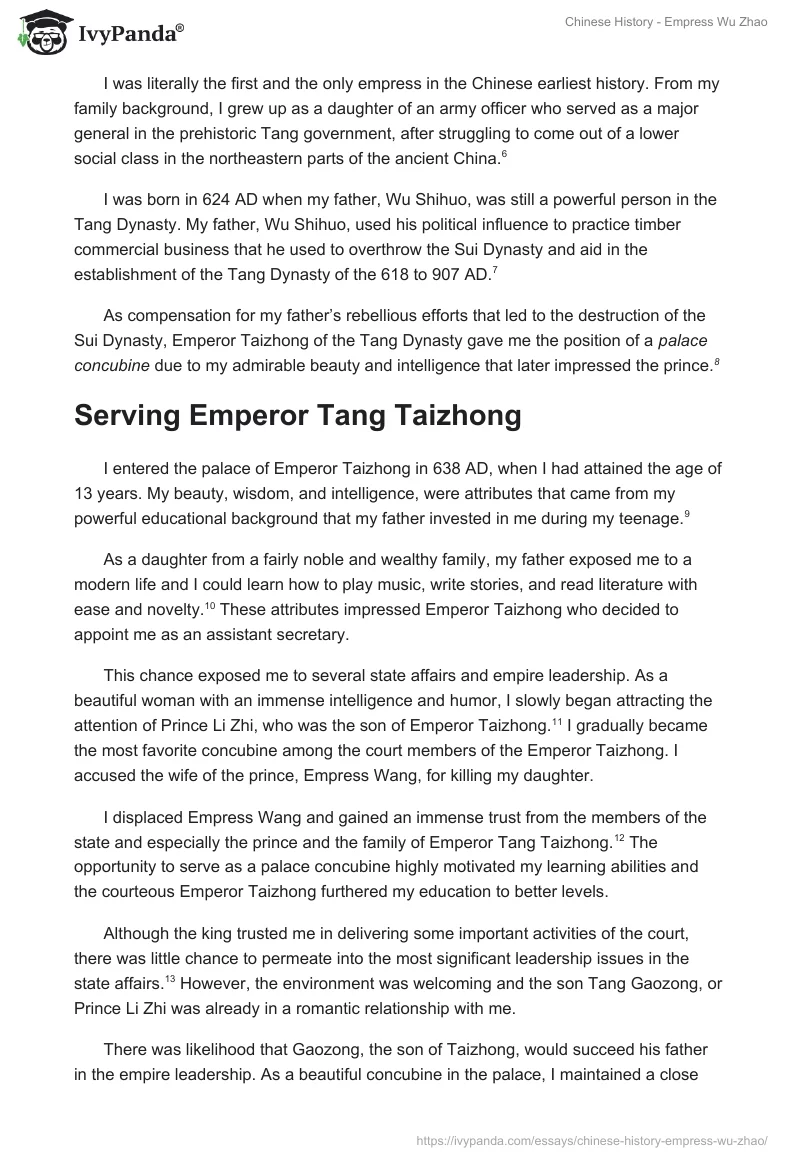Introduction
China underwent some crucial political transformations during its prehistoric moment. During its prehistoric regime, China underwent through several dynasties and political regimes that are significant to the present-day China. One of the most important political figures in the prehistoric China was Empress Wu Zhao, who established her own dynasty and reigned from 690 to 705AD.
Being the first female emperor of China, Empress Wu Zhao gained supreme power that enabled her to engineer some important historical moments in the Chinese history. Despite her influence in the Chinese history, people know little about her historical background, her social life, and her contribution to the several aspects of the Chinese history.
This essay focuses on discussing the social and political life of Empress Wu Zhao, as the first Chinese empress in the Chinese history and her special contribution to the Tang Dynasty and the uprising of the Chinese women in the colonial China.
My Initial Background as Empress Wu Zhao
I was a child of a Buddhist mother known as Yang Rongguo, who imparted the values of Buddhism during my childhood, before I interacted with the court members in the palace of Emperor Taizhong. Being from the Wenshui County of the Shanxi Province, education and leadership were important during that moment, but there were rare opportunities for any of the poor individuals who aspired to lead the Chinese.
My father, Wu Shihuo, was a powerful rebel against the leadership of the Sui Dynasty that slightly managed to unify China after a series of civil wars and endless disorders that the Han Dynasty instigated back in 220 AD. During the prehistoric China, the Chinese lived under the Confucian belief that disallowed the direct engagement of a woman in leadership. Women would rarely engage in the national leadership and for that reason, I served in the Buddhist religion as a humbled and a powerful nun.
I was literally the first and the only empress in the Chinese earliest history. From my family background, I grew up as a daughter of an army officer who served as a major general in the prehistoric Tang government, after struggling to come out of a lower social class in the northeastern parts of the ancient China.
I was born in 624 AD when my father, Wu Shihuo, was still a powerful person in the Tang Dynasty. My father, Wu Shihuo, used his political influence to practice timber commercial business that he used to overthrow the Sui Dynasty and aid in the establishment of the Tang Dynasty of the 618 to 907 AD.
As compensation for my father’s rebellious efforts that led to the destruction of the Sui Dynasty, Emperor Taizhong of the Tang Dynasty gave me the position of a palace concubine due to my admirable beauty and intelligence that later impressed the prince.
Serving Emperor Tang Taizhong
I entered the palace of Emperor Taizhong in 638 AD, when I had attained the age of 13 years. My beauty, wisdom, and intelligence, were attributes that came from my powerful educational background that my father invested in me during my teenage.
As a daughter from a fairly noble and wealthy family, my father exposed me to a modern life and I could learn how to play music, write stories, and read literature with ease and novelty. These attributes impressed Emperor Taizhong who decided to appoint me as an assistant secretary.
This chance exposed me to several state affairs and empire leadership. As a beautiful woman with an immense intelligence and humor, I slowly began attracting the attention of Prince Li Zhi, who was the son of Emperor Taizhong. I gradually became the most favorite concubine among the court members of the Emperor Taizhong. I accused the wife of the prince, Empress Wang, for killing my daughter.
I displaced Empress Wang and gained an immense trust from the members of the state and especially the prince and the family of Emperor Tang Taizhong. The opportunity to serve as a palace concubine highly motivated my learning abilities and the courteous Emperor Taizhong furthered my education to better levels.
Although the king trusted me in delivering some important activities of the court, there was little chance to permeate into the most significant leadership issues in the state affairs. However, the environment was welcoming and the son Tang Gaozong, or Prince Li Zhi was already in a romantic relationship with me.
There was likelihood that Gaozong, the son of Taizhong, would succeed his father in the empire leadership. As a beautiful concubine in the palace, I maintained a close romantic relationship with Gaozong or Prince Li Zhi. By this moment, I was familiar with most of the state affairs.
Gaozong Era: Death and Succession of Taizhong
In 649 AD, Emperor Taizhong died and the son, Gaozong, succeeded him in the leadership. Prior to the demise of the emperor, the traditions required me to enter the Buddhist convent. However, Gaozong being the new emperor brought me back to the palace and made me her chief wife. Although we never managed to have kids with Gaozong, I had two sons known as Li Xian3 and Li Dan, whom I got outside the wedlock.
Emperor Gaozong was ever a sickly emperor and the political pressure that was persistent at that moment made him suffer a stroke disease five years after bringing me to the place. Due to the stroke troubles that brought about difficulties in his walking and talking, I acted as his co-partner in his leadership. Since Gaozong could not rule effectively because of his ill health, I slowly began to apply my political skills beyond the knowledge of Gaozong.
In 660 AD, the health condition of Gaozong had worsened because he suffered an eye disease that blinded him. I gradually began to grasp the real leadership in the disguise of assisting the incapacitated Gaozong. I co-partnered with Gaozong indirectly as I mischievously stole some leadership secrets and gossiped regularly. I offered Gaozong a 12-point strategic plan that transformed the Chinese government.
Being compassionate, my plan suggested the lowering of taxes, the reporting of unfair treatments by mercantile and officials, and the allocation of the reserved land to the landless farmers. In 674 AD, emperor Gaozong renamed himself as Tian Huang and I renamed myself as Tian Hou. I became very popular among the Chinese people and gained a lot of fame.
I was literally familiar with almost every important aspect of the leadership and the people had already begun to respect my decisions in the court and on the lives of the Chinese civilians.
Empress Zhao: the Birth of the Zetian Regime
In 683 AD, Gaozong died and I ruled indirectly through my two sons whom I placed onto the throne. Li Xian3 became emperor Zhongzong and Li Dan became Emperor Ruizong. However, the real power was with me as the court officials trusted my intelligence, powerful women in the imperial court supported my decisions, and the police officers became submissive to me. In 690 AD, I deposed Emperor Ruizong and declared myself Emperor Zetian at an age of 65 years.
My leadership skills were incomparable as I was a strategic planner and an effective reformer in the education systems of China and in the leadership of the Chinese. I renovated roads, I improved agriculture, I endorsed female leadership, I unified the women in the empire, and reinforced civil justice. In 705 AD, I could not rule effectively due to old age and sickness. The generals seized the palace and I had to give the throne back to Emperor Zhongzong.
Conclusion
Perhaps the uprising of the Chinese women began with the Zetian regime that Empress Zetian had fostered through her intelligence and wit. Empress Zetian began from a humble background to a powerful woman in the imperial courts of the Chinese leadership systems. Although many historians often criticize the approach that Empress Zetian used to assume the leadership, her uprising was noteworthy.
Although she displaced Empress Wang and later disposed her own son, Emperor Zhongzong, her power was important in transforming the Chinese leadership. Women empowerment, education for the underprivileged, civil justice, reforms in the road construction sector, and fair leadership styles were some of the important leadership foundations of Wu Zetian.
Her wisdom in using Confucianism, Buddhism, and Daoism in her leadership, promoted religious fairness, even though she used the religions for her personal political interests to dominate the Chinese leadership.
Works Cited
Eisenberg, Andrew. “Emperor Gaozong, the rise of Wu Zetian, and factional politics in the early tang.” Tang Studies Journal 2012.30 (2012): 45-69. Print.
McMahon, Keith. “Women Rulers in Imperial China.” Nan Nü Journal 15.2 (2013): 179-218. Print.
Rothschild, Harry. Wu Zhao: China’s Only Woman Emperor, London, UK: Pearson Longman, 2008. Print.
West, Barbara. Encyclopedia of the Peoples of Asia and Oceania, Cambridge, UK: InfoBase Publishing, 2009. Print.


